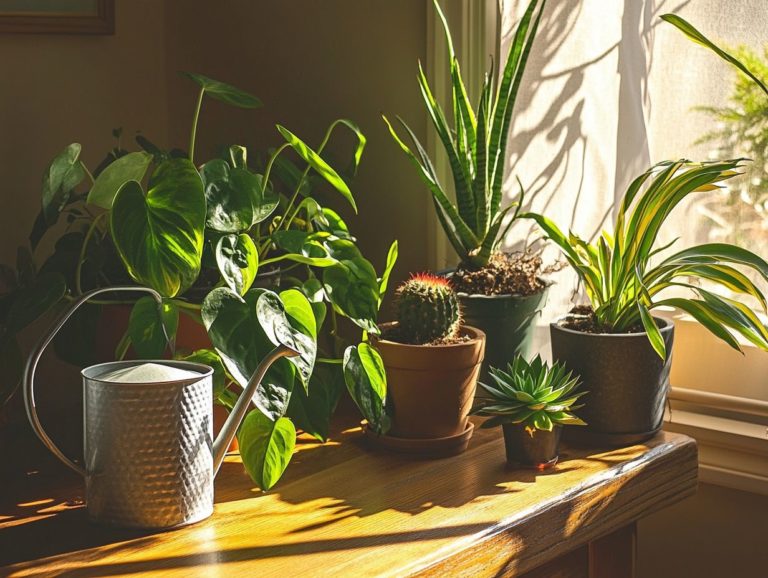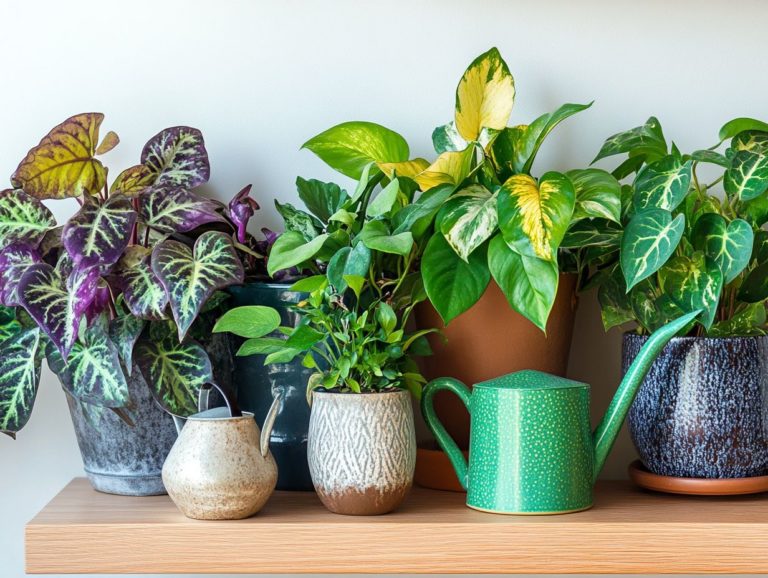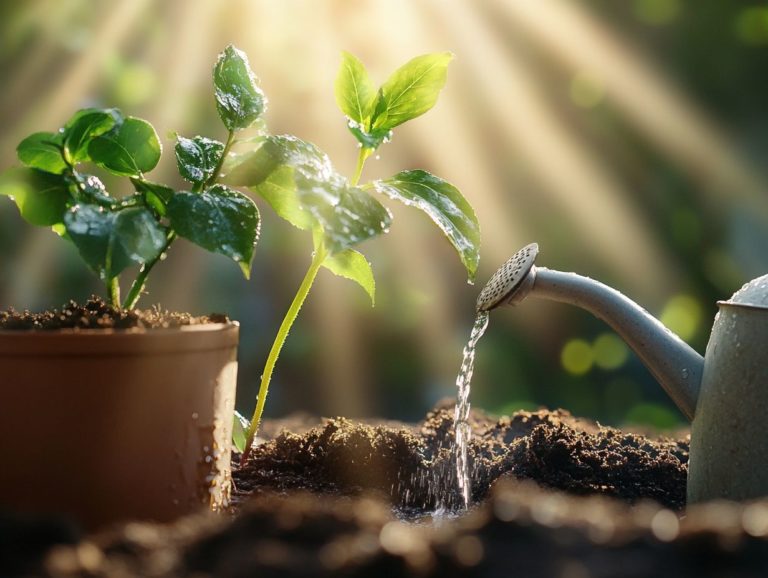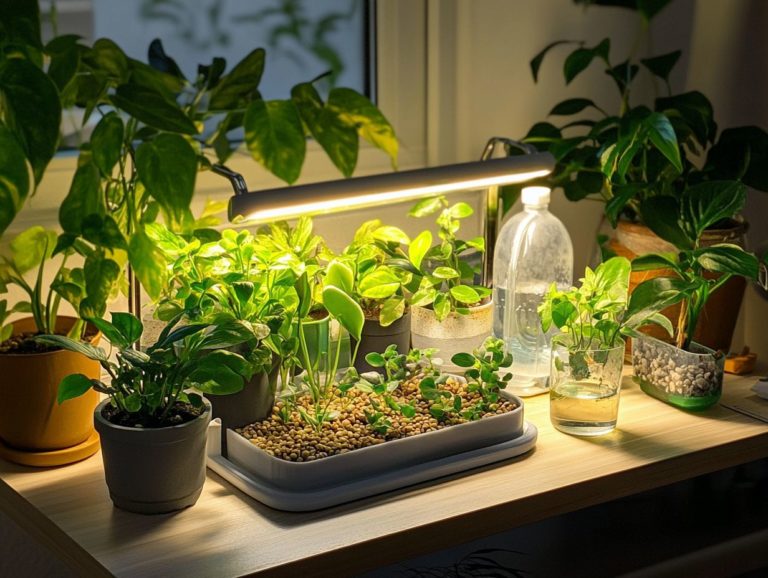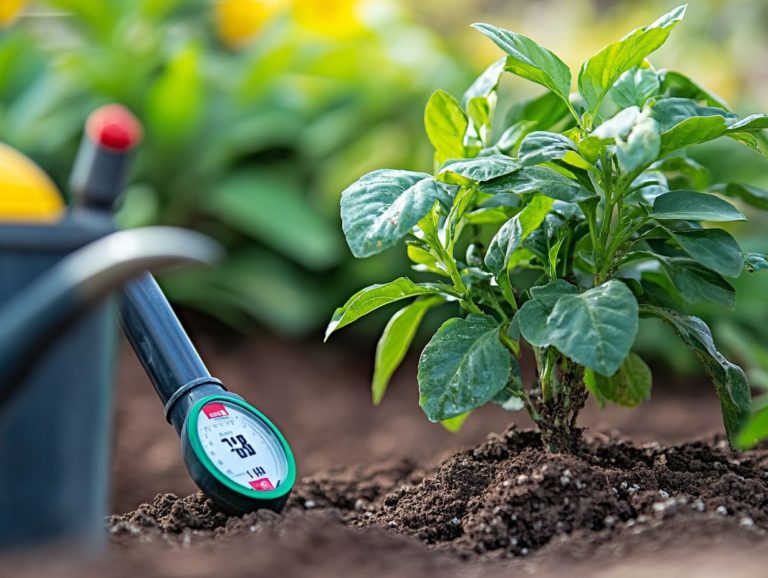Watering Techniques for Newly Potted Plants
Newly potted plants add a refreshing touch to any space, but they also bring unique care requirements that can influence their survival, especially in outdoor gardening settings.
Learning how to water your new plants effectively is key to their health. Understanding proper watering techniques is crucial for their growth and vitality, particularly in container gardening.
This article delves into the key factors you should consider before watering, effective techniques tailored to different plant types and soil conditions, and best practices to ensure your plants flourish, including watering correctly.
Whether you re a seasoned gardener or just embarking on your botanical journey, these insights will empower you to nurture your plants with confidence and enhance their health.
Contents
Key Takeaways:
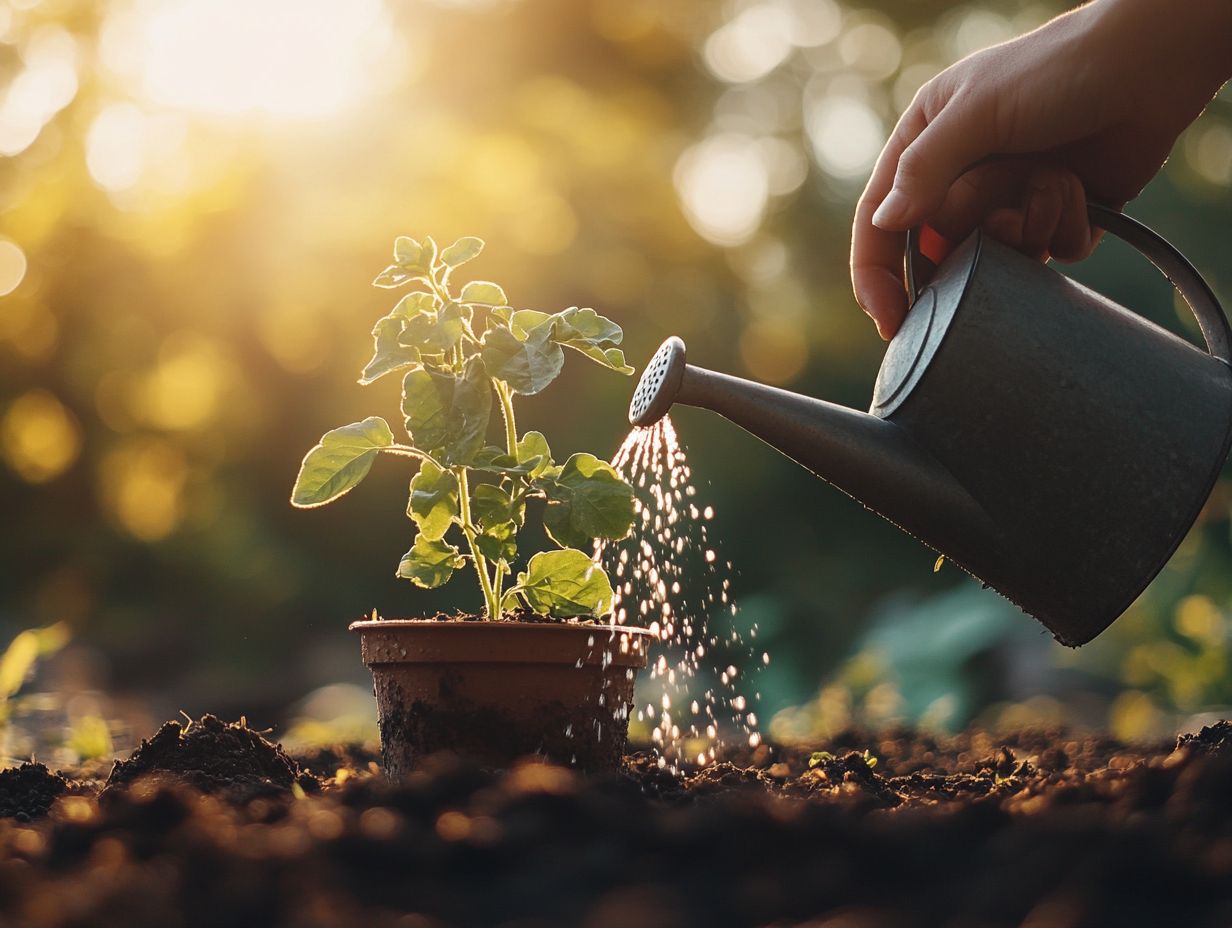
- Understanding the specific needs of newly potted plants is crucial for their overall health and growth.
- The frequency and amount of watering should be adjusted based on the type of plant and the type of soil it is potted in.
- Properly watering newly potted plants requires careful observation of watering signs, adjusting for weather conditions, and following best practices for watering, including recognizing the signs of under-watering and over-watering.
Understanding the Needs of Newly Potted Plants
Newly potted plants demand your careful attention to their specific needs in both container and outdoor gardening settings. It’s essential to grasp factors like soil moisture and the distinct requirements of flowering annuals or succulent plants to ensure their health.
Using well-drained soil is significant. Selecting the right container size with adequate drainage holes also profoundly influences your plants’ growth.
Factors to Consider Before Watering
Before you water your newly potted plants, consider several key factors that impact their health, including moisture control and soil dryness. Evaluate elements like soil dryness, root systems, and the risks associated with under-watering or over-watering this will help you formulate the ideal watering strategy.
To assess how dry the soil truly is, check both the surface layer and deeper levels. This can reveal any moisture retention issues lurking beneath, especially in potting soil that contains perlite or other moisture-retaining components. Understanding root systems is equally important, as different plants, including tomatoes, cucumbers, and melons, have varying root depths and spreads, which dictate their specific water needs.
Implementing effective moisture control techniques will help you create a balanced environment. This ensures your plants receive just the right amount of water to thrive without becoming oversaturated, thereby reducing the risk of foliage diseases. Striking this balance through careful observation and informed knowledge is essential to nurturing these growing wonders.
Watering Techniques for Different Types of Plants
Effective watering techniques differ considerably across various plant types, from flowering annuals to succulent varieties and those found in vegetable gardening. Grasping these distinctions is essential for your success in container gardening, ensuring that each plant receives the precise hydration it requires to thrive.
Watering Frequency and Amount
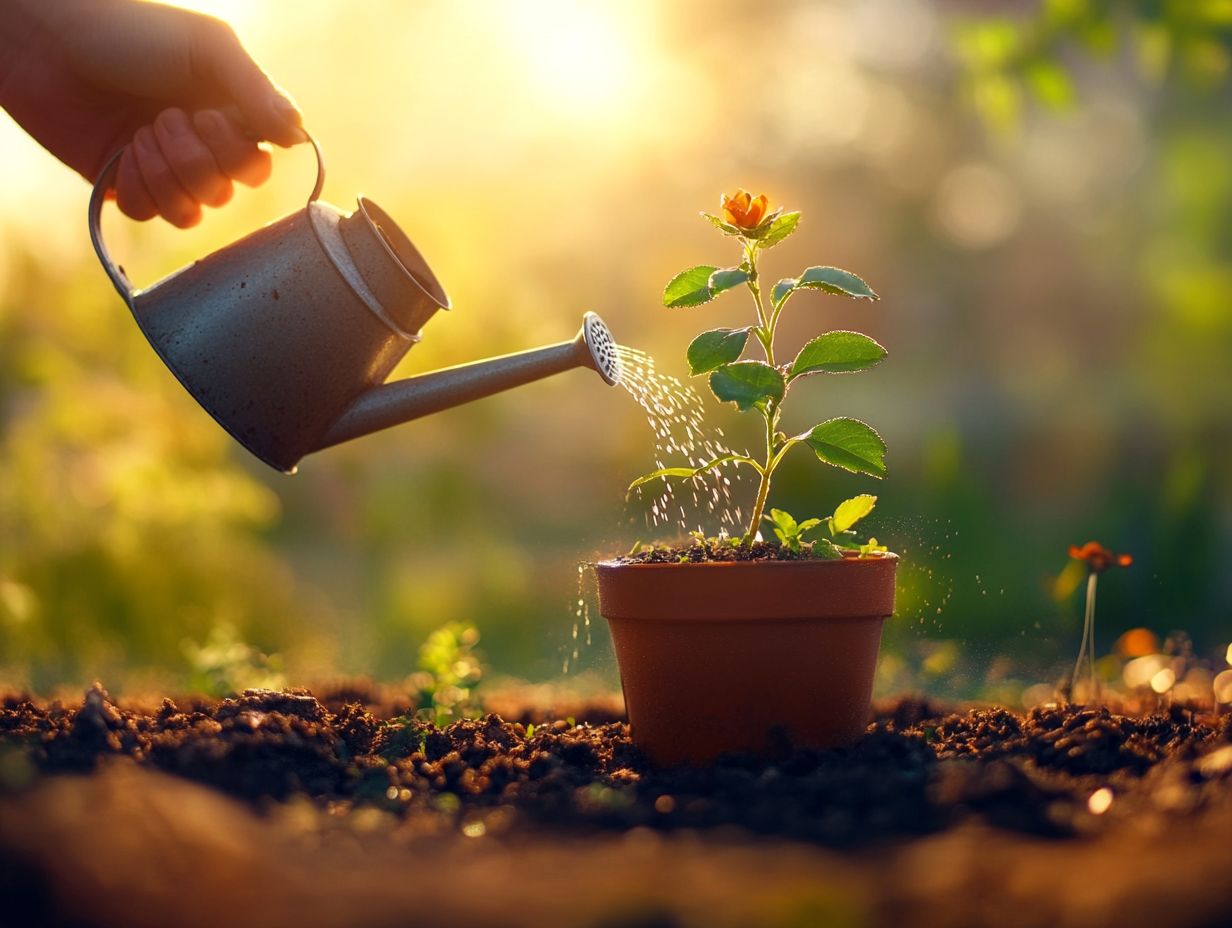
Finding the right watering frequency and amount is key to keeping your plants healthy! In container gardening, you’ll need to watch your plants closely to avoid overwatering.
You should consider factors like soil moisture and the risks of overwatering and underwatering to create an effective watering schedule. Regularly checking moisture levels and understanding the specific needs of each plant species, including herbs and vegetables, is essential.
A simple technique to check soil moisture is to insert your finger about an inch into the soil. If it feels dry at that depth, it s time to give your plants a drink, ensuring you’re watering deeply.
As the seasons change from warm summer days to cooler autumn breezes your watering needs will change too, particularly with humidity levels. Adjusting your routine based on weather patterns, humidity levels, and the specific needs of your plants helps ensure they receive optimal hydration!
This approach minimizes the risk of root rot, a condition where plant roots decay due to excessive moisture, or dehydration, which can be worsened by poor drainage.
Watering Methods for Different Soil Types
The choice of watering methods significantly impacts the various soil types you use in container gardening. This is particularly important for well-drained soil and potting mixes, such as those containing perlite for better drainage.
Understanding how these elements affect moisture control and rainwater penetration is crucial for optimizing your plants’ health, especially when using a rain barrel for irrigation. For instance, lighter potting mixes that incorporate coir or perlite generally promote faster drainage, meaning you might need to water more often.
In contrast, heavier mixes hold onto moisture longer, increasing the risk of waterlogging and powdery mildew. Each soil composition changes how water interacts with it, affecting nutrient availability and root health, which are vital for growing vegetables and herbs.
Using techniques like drip irrigation or soaker hoses allows you to deliver moisture directly where it’s needed! This reduces runoff and evaporation, ensuring effective hydration for your plants.
By tailoring your watering methods to specific soil types, you ensure your plants receive just the right amount of hydration, allowing them to flourish in their containerized environments.
Tips for Properly Watering Newly Potted Plants
Watering your newly potted plants the right way can make all the difference! Recognizing the signs of overwatering and underwatering enables you to adopt best practices that help your plants thrive.
Signs of Overwatering and Underwatering
It’s essential to recognize the signs of overwatering and underwatering to maintain your plants’ health. Both conditions can lead to serious issues, including foliage diseases and impaired soil moisture levels.
Watch for signs of overwatering, such as yellowing leaves, wilting even when the soil is wet, and root rot, which feels mushy and may smell foul. In contrast, underwatered plants often show dry, crispy leaves, stunted growth, and soil that pulls away from the pot’s edges. Both issues can significantly affect a plant s vitality and growth potential.
As a gardener, establishing a consistent watering schedule and ensuring proper drainage can help alleviate these problems. Checking soil moisture regularly is also beneficial. Using a moisture meter can help you know when to water, creating a healthier environment for your plants to flourish!
Best Practices for Watering
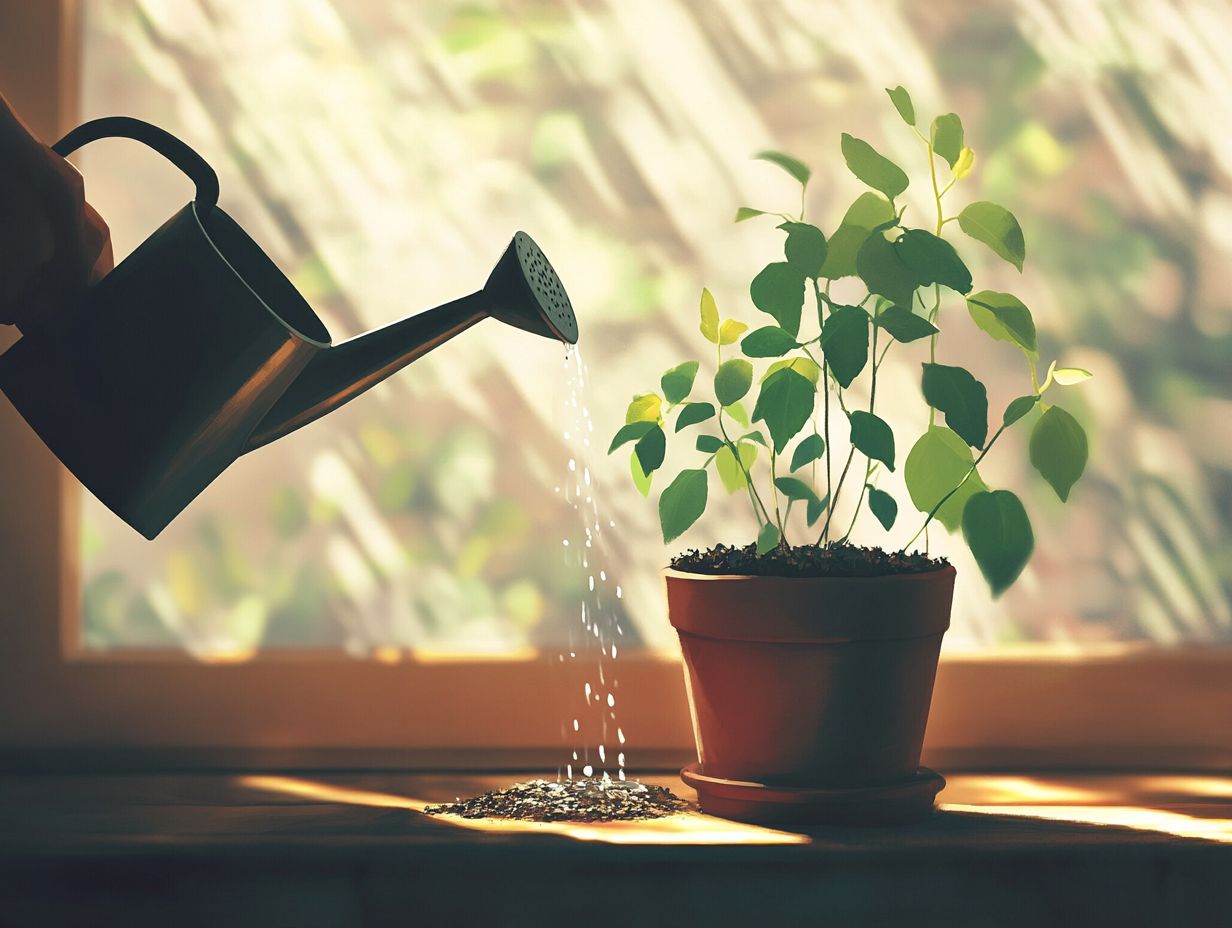
Implementing best practices for watering your newly potted plants is crucial for ensuring their vitality and success. Techniques like watering in the morning minimize evaporation and enhance moisture control. This promotes healthy growth.
Understanding the specific needs of different plant types, including succulents and flowering annuals, allows you to craft more tailored watering strategies. This ensures you provide adequate hydration without drowning the soil. Timing is everything! Watering during cool morning hours helps roots absorb moisture effectively, especially during hot summer months.
Check for drainage by confirming that your pots have holes at the bottom. This simple step prevents waterlogging, which can harm plant health. Choose a potting mix that retains moisture and allows airflow, such as those containing vermiculite, to help your plants thrive.
Additional Considerations for Watering Newly Potted Plants
Several factors can influence the watering needs of your newly potted plants, particularly environmental elements like temperature and humidity.
Adjust your watering schedule based on seasonal changes. Keep a close eye on soil dryness, especially during dry spells in summer. These strategies will help maintain optimal plant health and ensure your greenery thrives.
How Temperature and Humidity Impact Your Plants
Temperature and humidity significantly influence the watering needs of your newly potted plants. These factors affect soil moisture levels and overall plant health.
When temperatures soar, water evaporates quickly, leading to faster moisture depletion in the soil. Monitor your plants’ hydration needs closely. Low humidity can cause the soil to dry out faster, requiring more frequent watering.
If you live in a hot and dry climate or during dry spells, be ready to water your plants more often to keep moisture levels steady. Conversely, when the weather cools or humidity increases, your soil may retain moisture longer, allowing you to extend watering intervals and reduce the risk of overwatering.
Stay informed about weather patterns, like rainfall, and adjust your watering practices accordingly. This ensures your plants stay hydrated without the danger of overwatering.
Adjusting Watering Schedule for Different Seasons
Adjust your watering schedule for newly potted plants to meet distinct seasonal needs. As the seasons change, so do soil dryness and moisture retention. Tailor your watering practices for optimal plant health and to prevent issues like root rot, which occurs when roots sit in water too long.
With fluctuating temperatures and changing rainfall patterns, regularly monitor the moisture levels in your soil. During warmer months, your plants will typically need more frequent watering due to increased water loss. Cooler seasons will call for less irrigation.
A straightforward approach is to check the soil with your finger. If it feels dry an inch below the surface, it s time to give your plants a drink. During rainy spells, allow the soil to dry out slightly before watering again to prevent root rot and promote healthy growth.
Frequently Asked Questions
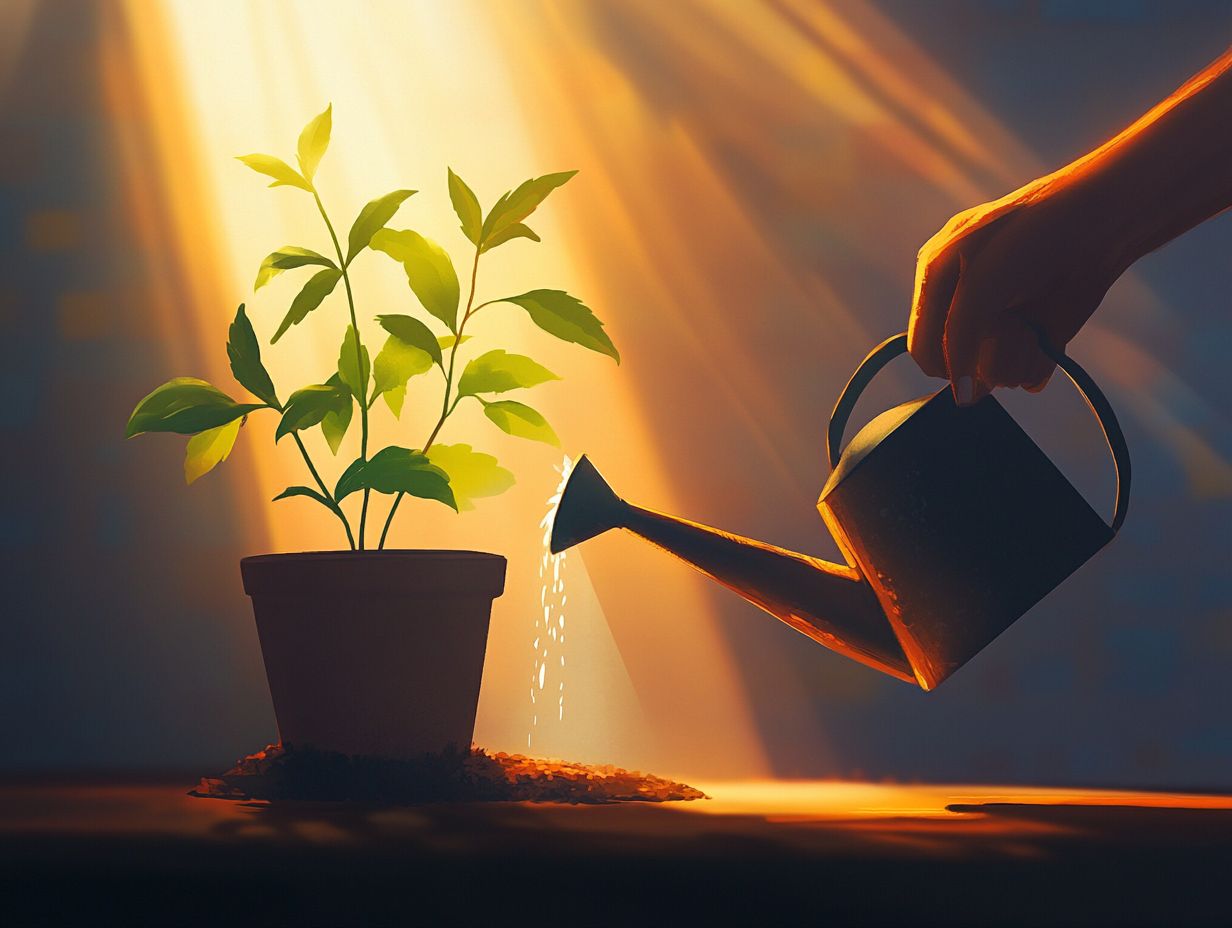
- How often should I water my newly potted plants?
- What is the best time of day to water?
- How can I tell if my plants are getting too much water?
What are the best watering techniques for newly potted plants?
The best watering technique for newly potted plants is to thoroughly water the soil until it is evenly damp. Pour water slowly at the base of the plant until it drains out of the bottom of the pot. Water deeply to encourage strong root systems and support resistance to foliage diseases.
When should I water my newly potted plants?
Water your newly potted plants immediately after repotting. Then, water again when the top inch of soil feels dry to the touch. This may vary depending on the type of plant and its specific water needs, including sensitive succulent plants that require careful monitoring to keep the plants from drying out. Also, consider the container size when determining your watering schedule.
How often should I water newly potted plants?
The frequency of watering newly potted plants depends on factors like the type of plant, size of the pot, and environmental conditions. Most potted plants thrive with watering 1-2 times a week. Always check the soil first to make sure! For flowering annuals and herbs like basil, rosemary, and thyme, you may need to adjust your schedule based on their moisture needs, especially during morning watering sessions.
What is the best way to water newly potted plants?
The best way to water newly potted plants is to use a watering can or a hose with a gentle spray nozzle to avoid disturbing the soil. You can consider using a self-watering pot or adding a layer of mulch on top of the soil to help retain moisture. This method is especially effective for succulents and vegetables like tomatoes, cucumbers, and melons. Keep an eye out for powdery mildew, which can result from improper watering practices.
Can I overwater my newly potted plants?
Yes, overwatering newly potted plants is a common mistake. It can lead to root rot and other issues.
Always check the soil moisture before watering. Ensure the pot has proper drainage to prevent overwatering.
This is especially critical for succulents, which are sensitive to excess moisture.
What should I do if my newly potted plant is wilting?
If your newly potted plant is wilting, it may indicate overwatering or underwatering. Check the soil moisture and adjust your watering schedule accordingly.
If the plant keeps wilting, it might be a sign of root damage. Consult a plant expert for advice.
Consider using perlite, a lightweight material that improves soil drainage, to help prevent these issues.

